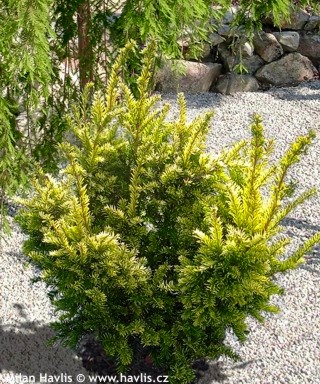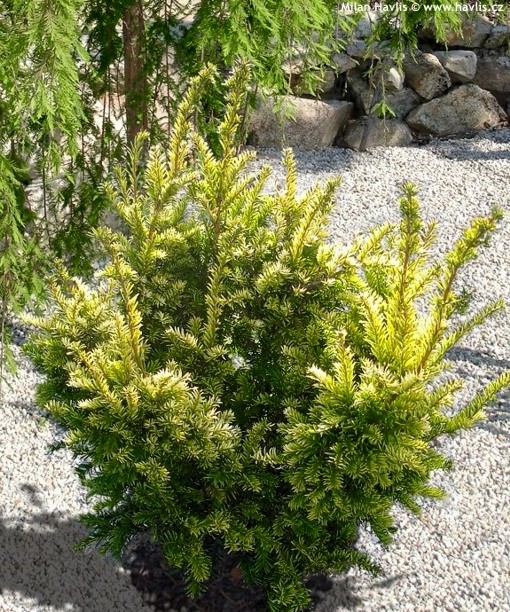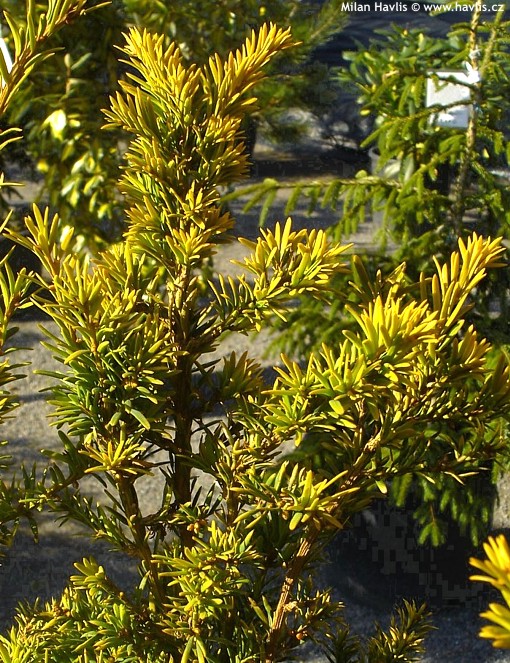Taxus baccata 'SEMPERAUREA' yew
Taxus
Yews could be called common shrubs, where common not only means omnipresent but mainly dull. Well, perhaps for someone. We see yew and predominantly its varieties as very useful and attractive features of gardens of almost any size. They vary by size, shape and even foliage colour.
Semperaurea is an attractive variety of yew. Its evergreen needles are bright yellow on the top of the shrub from spring to autumn and change to orange or golden yellow in winter. Foliage inside the shrub and on not insolated parts grade to mid to deep green. The plants grows at medium speed, making erect new shoots and forms a dense, wide shrub.
Now a few words about its toxicity. The whole plant is slightly poisonous for humans but extremely poisonous for horses. Its beautiful red fruits are also said to be dangerous for people but the truth is that only the seeds contain a certain amount of substance that could be dangerous only if bitten into. As a matter of interest the flesh of the berries is found sweet and delicious for many and if the seed is spat out you can expect no harm. Also, tests proved that seeds not bitten into will go through the digestion system causing no harm. Well, our final suggestion is to use this plant as a decorative item in your garden, not a dessert.
Yews are easy to grow. They can take almost any soil type from acidic to alkaline, even wet conditions. They will do well in full sun as well as shade but this variety will look brightest yellow in full sun. They respond very well to pruning and can be pruned hard. This variety is extremely hardy that withstands severe winds and frosts down to -29°C (USDA zone 5).
Last update 01-12-2010
Goods are shipped all over Europe. For Russia and U.K. and for further details please read about SHIPPING OPTIONS HERE.
Are you interested in a serious discount for orders NOV-FEB? Check your options here.
THE PRICES INCLUDE VAT of 15%. For quick conversion you can use 1 CZK = approx. 0.04 EUR
- STANDARD QUALITY - Plants of this group are 1st class quality with number of branches and overall density adequate to their size and age, considering they were container grown.
- DE LUXE QUALITY - This label guarantees a luxurious quality of manually selected plants that, compared to their height and age, are exceptionally dense and beautiful.
- EXTRA - These plants are usually mature and bigger specimens with exceptional overall appearance.
- STANDARD (as described in the plant form) means a tree with a trunk of 190-210 cm and a crown at the top, unless specified differently. The commercial size for trees is their girth measured in the height of 1m from ground.
- HOBBY - These plants are of the same quality as our standard-quality plants but younger and therefore cheaper.
- SHRUB - a woody plant with branches growing bushy from the ground level.
- HALF-STANDARD or MINI-STANDARD - a small tree with shorter trunk, its size is usually specified.
- FEATHERED - These are trees with branches growing already from the base of the trunk and up along the stem.
- GRASSES and PERENNIALS - Sizes given usually read the diameter of the pot or the clump, as specified.






































